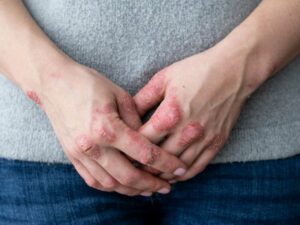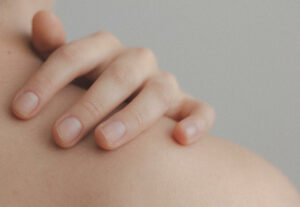Diabetes, a chronic condition affecting millions worldwide, doesn’t just impact blood sugar levels. One lesser-known but equally distressing symptom is skin itching. This itching, often overlooked, can significantly impair quality of life. In this blog, we delve into why diabetes causes skin itching and, more importantly, how to effectively treat and manage it. From lifestyle changes to medical diabetes itching skin treatments, we’ll explore a range of strategies to help.
Contents
Why Diabetes Causes Itching Skin?
 Diabetes can cause itching skin for several reasons:
Diabetes can cause itching skin for several reasons:
- High Blood Sugar Levels: Elevated blood sugar levels, a hallmark of diabetes, can lead to dry skin, which is often itchy. High glucose levels can cause the body to lose fluids more quickly, leading to dehydration and dry skin.
- Poor Circulation: Diabetes can affect blood circulation, especially in the extremities like the legs and feet. Poor circulation can lead to skin changes, including itchiness and dryness.
- Nerve Damage (Diabetic Neuropathy): Diabetes can damage the nerves in the body, a condition known as diabetic neuropathy. This damage can cause a variety of sensations in the skin, including tingling, burning, and itching.
- Yeast Infections: High levels of sugar in the body can promote the growth of yeast, particularly in warm, moist areas of the skin. This can lead to fungal infections, which are often itchy.
- Skin Conditions: People with diabetes are more prone to certain skin conditions that can cause itching, such as diabetic dermopathy, necrobiosis lipoidica diabeticorum, and eruptive xanthomatosis. These conditions are directly related to diabetes and its effects on the body.
- Allergic Reactions to Medications: Some people with diabetes may experience allergic reactions to their medications, which can manifest as itchy skin.
- Kidney Disease: In later stages, diabetes can lead to kidney disease. It can cause itching due to the buildup of waste products in the body.
Understanding these causes is crucial for effectively managing and treating the itchiness associated with diabetes. Regular monitoring of blood sugar levels, maintaining good skincare, and consulting with healthcare professionals for appropriate treatment can help alleviate these symptoms.
What Are The Diabetes Itching Skin Treatments?
Diabetes itching skin treatments involve a combination of good diabetes management, skincare, and possibly medical treatments. Here are some effective strategies:
Control Blood Sugar Levels
Effective management of blood sugar levels is paramount in reducing the risk of skin itching and other diabetes-related complications. Consistently high blood sugar can cause the body to lose fluids, leading to dry, itchy skin. Patients should work closely with their healthcare providers to monitor and maintain their blood sugar within recommended ranges. This may involve adhering to prescribed medication regimens, regularly monitoring blood glucose levels, and making appropriate lifestyle changes, such as diet and exercise.
Moisturize Regularly
 Keeping the skin well-moisturized is a simple yet effective way to reduce itching. Moisturizers help lock in moisture, preventing dryness and irritation. It’s advisable to choose moisturizers that are free from fragrances and irritants, and specifically designed for sensitive or diabetic skin. Applying moisturizer immediately after bathing, when the skin is still damp, can be particularly effective in retaining moisture.
Keeping the skin well-moisturized is a simple yet effective way to reduce itching. Moisturizers help lock in moisture, preventing dryness and irritation. It’s advisable to choose moisturizers that are free from fragrances and irritants, and specifically designed for sensitive or diabetic skin. Applying moisturizer immediately after bathing, when the skin is still damp, can be particularly effective in retaining moisture.
Gentle Skincare Products
Using mild, non-irritating soaps and skin care products is essential. Products formulated for sensitive skin, without harsh chemicals, dyes, or fragrances, are less likely to irritate. This also extends to laundry detergents, as residues from harsh detergents can irritate the skin.
Bathing Habits
Hot water can strip the skin of its natural oils, exacerbating dryness and itching. It’s better to use lukewarm water and to limit bathing or showering time. After bathing, gently patting the skin dry instead of rubbing can prevent further irritation.
Use a Humidifier
In dry climates or during colder months when indoor heating can dry out the air, using a humidifier adds moisture back into the environment. This helps keep the skin from becoming too dry, reducing the risk of itching.
Treat Underlying Conditions
Any underlying skin conditions, such as fungal infections, should be treated promptly. These conditions are more common in individuals with diabetes and can contribute to skin irritation and itching. Prescription antifungal creams or oral medications may be necessary. It’s also important to maintain good hygiene and keep areas prone to fungal infections, like the feet, clean and dry.
Healthy Diet
Nutrition plays a vital role in managing diabetes and maintaining healthy skin. A diet rich in omega-3 fatty acids, vitamins, and antioxidants can improve skin health. Omega-3s, found in fish like salmon, flaxseeds, and walnuts, help maintain the skin’s lipid barrier, essential for keeping skin hydrated. Foods high in antioxidants, such as berries, green leafy vegetables, and nuts, can combat inflammation and support overall skin health. Additionally, a balanced diet helps in regulating blood sugar levels, indirectly benefiting skin health.
Avoid Scratching
Scratching itchy skin can create micro-tears, leading to infections and worsening the condition. Keeping fingernails short and smooth can reduce damage from scratching. At night, wearing cotton gloves may prevent unconscious scratching. If the urge to scratch is overwhelming, gently patting or applying a cool compress to the area can offer relief without harming the skin.
Loose Clothing
Tight clothing can irritate sensitive skin, exacerbating itching. Wearing loose, breathable fabrics, such as cotton, can prevent irritation. Additionally, avoiding materials that trap heat and moisture (like synthetic fabrics) is important, especially for areas prone to fungal infections.
Manage Stress
Stress can have a significant impact on skin health and diabetes management. Stress triggers hormonal changes that can worsen skin conditions and increase blood sugar levels. Techniques such as mindfulness, yoga, deep breathing exercises, and meditation can be effective in reducing stress. Regular physical activity is also beneficial, not only for stress management but also for overall diabetes control.
Regular Skin Examinations
These self-examinations of the skin can help in the early detection of potential problems, such as infections, sores, or other changes. Paying special attention to areas that are harder to see, like the feet, is crucial for people with diabetes. Any changes in the skin’s appearance, texture, or sensation should be reported to a healthcare professional promptly.
By seeking these diabetes itching skin treatments, individuals can manage this more effectively and also improve their overall diabetes management and skin health. It’s important to remember that each individual’s situation is unique, and what works for one person may not work for another.
What Cream Is Good For Itching From Diabetes?
 For itching caused by diabetes, the choice of cream largely depends on the underlying cause of the itching and its severity. Here are some common options:
For itching caused by diabetes, the choice of cream largely depends on the underlying cause of the itching and its severity. Here are some common options:
- Moisturizing Creams
Dry skin is a common cause of itching, so using a good moisturizer is often the first line of defense. Look for creams that are fragrance-free and formulated for sensitive skin. Products containing ingredients like glycerin, lactic acid, urea, or hyaluronic acid can be particularly effective in keeping the skin hydrated.
- Hydrocortisone Cream
For mild itching, over-the-counter hydrocortisone creams can be helpful. Hydrocortisone is a mild steroid that can reduce inflammation and itching. It should be used sparingly and not for prolonged periods, as long-term use can lead to skin thinning.
- Antifungal Creams
If the itching is due to a fungal infection (common in areas like the feet and groin), an antifungal cream may be necessary. Ingredients like clotrimazole or miconazole can treat a variety of fungal infections.
- Topical Immunomodulators
For more severe or chronic itching, a doctor may prescribe topical immunomodulators like tacrolimus or pimecrolimus. These non-steroidal creams can help reduce inflammation and itching but are typically used when other treatments have failed.
- Topical Anesthetics
Creams containing pramoxine or lidocaine can provide temporary relief from itching by numbing the skin. They can be useful for immediate, short-term relief.
It’s important to note that while these creams can provide relief from itching, they do not cure the underlying cause. Managing blood sugar levels effectively is crucial for the long-term treatment of diabetes-related skin issues.
How Do You Stop Itching From Diabetes Down There?
 Itching in the genital area due to diabetes, often caused by fungal infections or skin irritation, requires specific care. Here are some additional strategies to address this issue:
Itching in the genital area due to diabetes, often caused by fungal infections or skin irritation, requires specific care. Here are some additional strategies to address this issue:
- Maintain Good Hygiene: Keep the area clean and dry. Gently wash with mild, non-fragranced soap and water. After washing, make sure to dry the area thoroughly, as moisture can promote fungal growth.
- Wear Breathable Underwear: Choose underwear made from natural fibers like cotton, which allows the skin to breathe and reduces moisture buildup. Avoid tight-fitting underwear and clothing that can cause irritation and increase sweating.
- Avoid Irritants: Steer clear of products that might irritate the area, such as scented soaps, shower gels, and laundry detergents with harsh chemicals. Also, avoid using feminine hygiene sprays or douches, as these can disrupt the natural balance of the area and lead to irritation.
- Change Wet Clothing Promptly: If you exercise or sweat heavily, change out of wet clothing as soon as possible. Staying in damp clothing can create an environment conducive to fungal growth.
- Use Anti-Fungal Treatments: If the itching is caused by a yeast infection, over-the-counter antifungal creams or suppositories may be effective. These products usually contain active ingredients like clotrimazole or miconazole.
- Seek Medical Advice: If the itching persists despite these measures, or if you notice other symptoms like redness, swelling, unusual discharge, or odor, it’s important to consult a healthcare provider.
It’s important to address genital itching promptly, as ignoring it can lead to more serious infections or complications. A healthcare provider can offer the most appropriate treatment based on the specific cause of the itching.
Conclusion
In conclusion, diabetes itching skin treatments involve a multifaceted approach that includes maintaining good blood sugar control, proper skin care, and lifestyle adjustments. From staying hydrated and using gentle skin care products to adopting a healthy diet and wearing breathable clothing, these strategies can significantly alleviate discomfort. It’s also important to address specific issues like genital itching with targeted care.
Remember, while creams and over-the-counter treatments can provide relief, consulting with a healthcare professional for persistent or severe symptoms is crucial. Do you want to get rid of diabetes? Join our online diabetes treatment program and reverse Diabetes naturally through lifestyle changes such as a Personalized Diet plan, Exercise, Yoga, dieticians, and health coaches.

